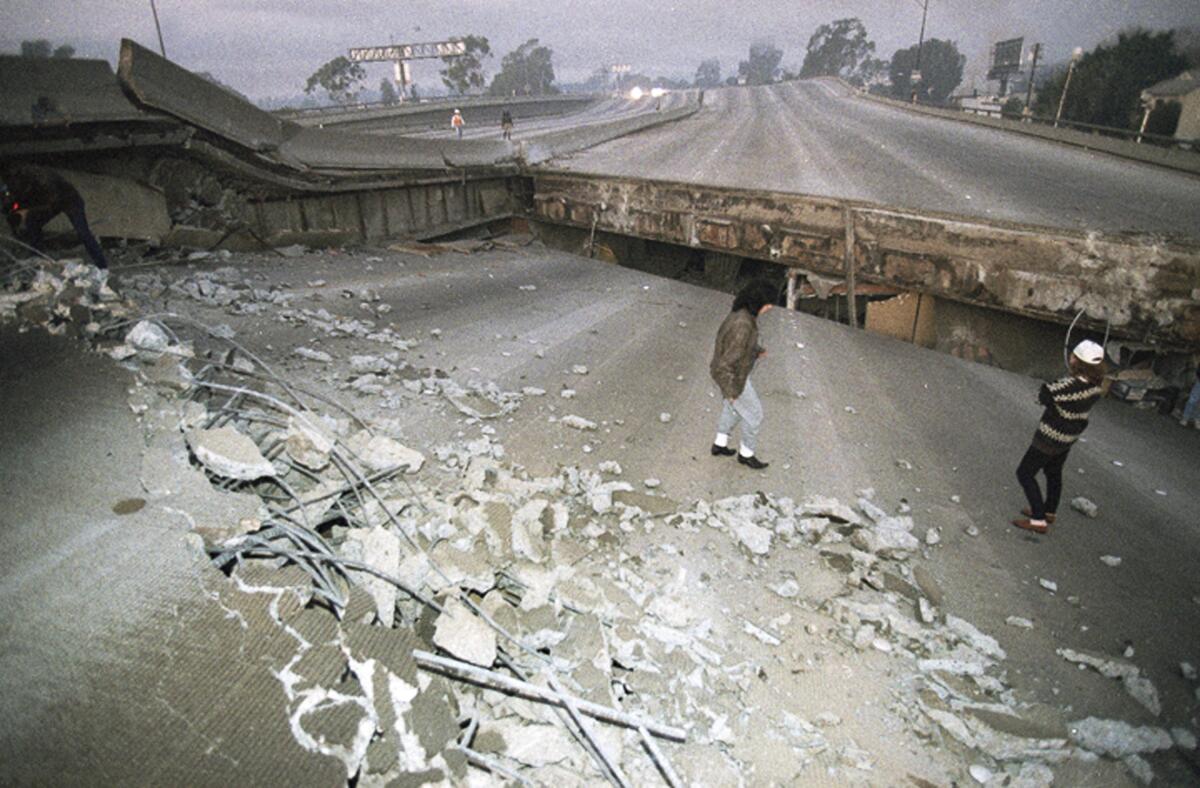The 1994 earthquake broke the 10 Freeway. How L.A. rebuilt it in record time

- Share via
The Jan. 17, 1994, Northridge earthquake damaged roadways across Los Angeles. But nowhere was the impact felt more acutely that on the 10 Freeway just east of Culver City.
The earthquake knocked out two freeway bridges, at La Cienega and Washington boulevards. It cut off what was central Los Angeles’ key east-west traffic corridor.
Round-the-clock repairs got the Santa Monica Freeway opened in less than three months — in what officials described as record time, giving L.A.’s quake recovery an important boost.
The fire that damaged the 10 Freeway a few miles east this weekend — again closing the roadway indefinitely — has brought comparison to 1994.
“For those of you that remember the 1994 Northridge earthquake, Caltrans worked around the clock to complete the emergency repairs to the freeways, and this structural damage calls for the same level of urgency and effort,” Mayor Karen Bass said Sunday.
It remains unclear how badly damaged the freeway hit by Saturday’s fire is and how long it will take to fix.
Here is a review of that epic 1994 repair effort from the pages of The Times.
A race against time
Officials knew right away they needed to get the freeway operating as soon as possible.
Some economist said the freeway collapse was one of the most costly impact of the Northridge quake.
With an average of 341,000 vehicles a day using the roadway, they said, the extra time it took goods to get to their destinations and workers to get to their jobs cost millions in lost production and wages.
Reporting at the time suggested the closure cost the economy $1 million a day.
The freeway collapse pushed traffic onto crowded surface streets between Santa Monica and downtown Los Angeles, as frustrated commuters sought alternative routes. Detours caused delays of 20 minutes or more.
How was the freeway repaired?
An accelerated construction effort — one spurred by round-the-clock work — led to reopenings ahead of schedule. In the case of the 10 Freeway, which saw two sections flattened by the quake, contractor C.C. Myers Inc. finished the project 74 days ahead of schedule, allowing it to reopen in April— about three months after the quake knocked it down. The company had been offered a $200,000 bonus for every day the work was finished ahead of schedule, The Times reported.
The price tag on the project rose from the original bid of $14.9 million to nearly $30 million.
It was an intense process.
- The damaged structure was torn down, roadways were cleared and the rubble hauled away.
- Shafts up to 50 feet deep were drilled for piles, concrete was poured for columns and piles. This took about three weeks.
- Ironworkers created a frame of steel that was later covered with concrete. Because the structures were 600 to 700 feet long, construction of the bottom slab and vertical wall supports began on one end as the structures were erected at the other end.
- Once formed, the top deck was surfaced.
- After waiting five days for the concrete to cure, tension was applied to metal strands, called tendons, which were placed in the concrete to add strength to the structure.
- Although the freeway was deemed safe from collapse, experts said the bridge abutments needed even more strengthening with the installation of pilings to avoid damage in a future quake.
- Steel rings were placed around the columns during construction to further strengthen them. The rings were inserted around the rebar before concrete was poured.
- On each of the two bridges, four pilings 4 feet in diameter and as much as 80 feet deep were attached to the sides of each abutment.
More to Read
Sign up for Essential California
The most important California stories and recommendations in your inbox every morning.
You may occasionally receive promotional content from the Los Angeles Times.













